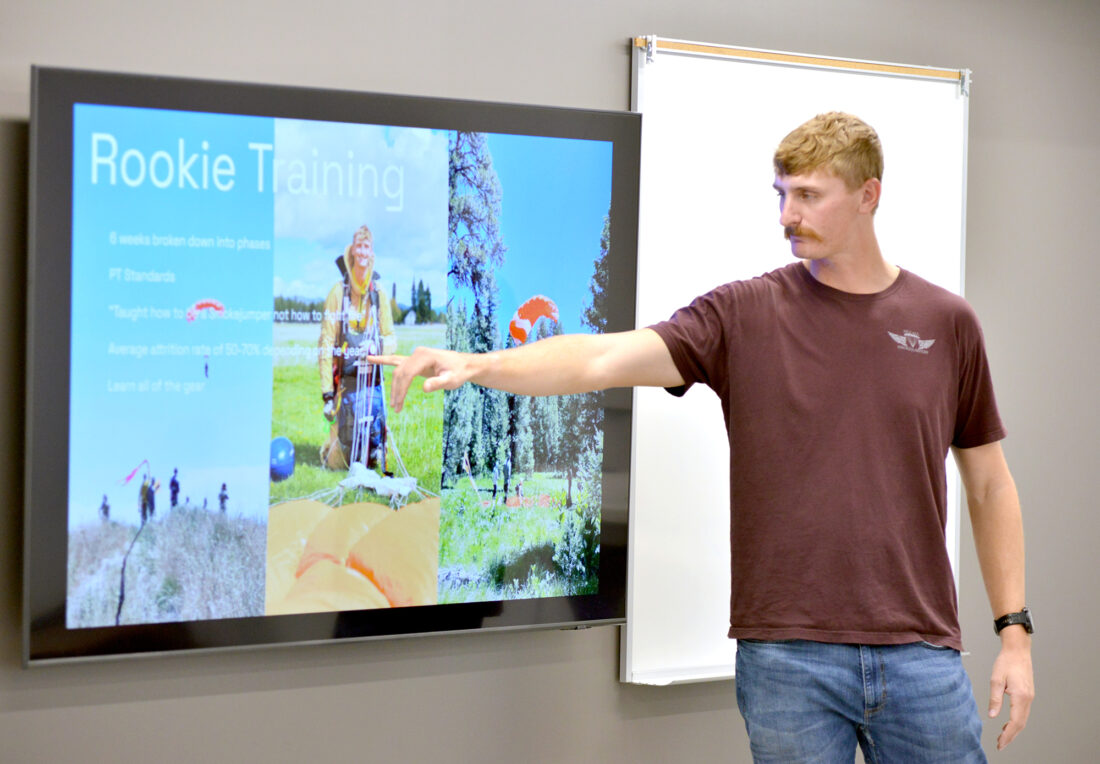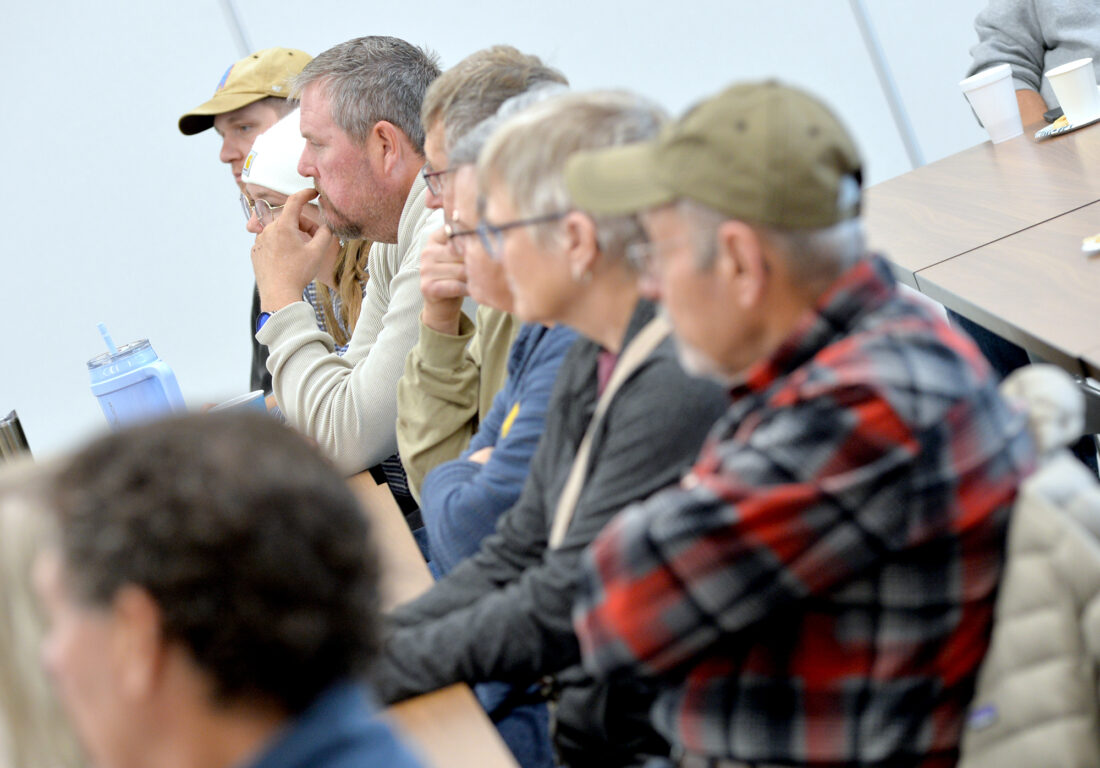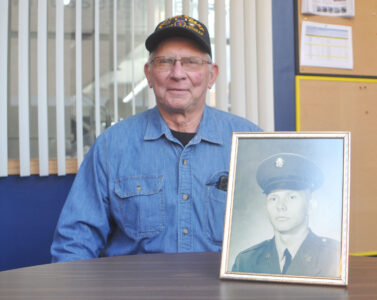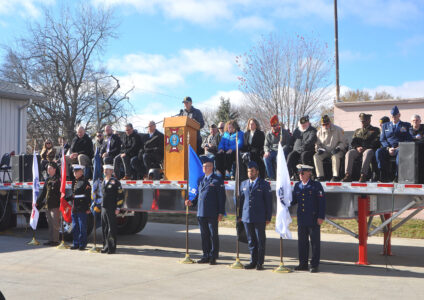Into the fire
When others are scurrying away from a blaze, Moorland native and smokejumper Jackson Johnson is heading toward it
-
-Messenger photo by Hans Madsen
Moorland native Jackson Johnson, who’s currently stationed at the U.S. Forest Service Smokejumper Base in McCall, Idaho, talks about his parachute rig during Coffee and Conservation at the Matt Cosgrove River’s Edge Discovery Center Saturday.
-
-Messenger photo by Hans Madsen
Members of the audience listen Saturday morning to Moorland native Jackson Johnson, who’s currently stationed at the U.S. Forest Service Smokejumper Base in McCall, Idaho, as he talks about his career during Coffee and Conservation at the Matt Cosgrove River’s Edge Discovery Center Saturday.

-Messenger photo by Hans Madsen
Moorland native Jackson Johnson, who's currently stationed at the U.S. Forest Service Smokejumper Base in McCall, Idaho, talks about his parachute rig during Coffee and Conservation at the Matt Cosgrove River's Edge Discovery Center Saturday.
Moorland native Jackson Johnson, who’s currently stationed at the U.S. Forest Service base in McCall, Idaho, showed a video of his commute to work during his presentation Saturday at the Coffee and Conversation session at the Matt Cosgrove River’s Edge Discovery Center.
It shows people jumping out of an airplane with heavy packs of gear, in addition to their parachutes.
So was there anything wrong with that plane?
“Absolutely not,” he said.
There is, however, something wrong on the ground near where he lands.

-Messenger photo by Hans Madsen
Members of the audience listen Saturday morning to Moorland native Jackson Johnson, who's currently stationed at the U.S. Forest Service Smokejumper Base in McCall, Idaho, as he talks about his career during Coffee and Conservation at the Matt Cosgrove River's Edge Discovery Center Saturday.
There’s a wildfire there, and his job, along with his fellow smokejumpers, is to put it out before it becomes a major blaze on the evening news.
Being a smokejumper is an elite position in the world of wildfire fighting.
“It’s not entry level,” Johnson said. “You have to have three to five years of experience to even apply. They’re training you how to be a smokejumper, not how to fight a fire. You should already be experienced at that part.”
Once he was accepted into the program, he went through six weeks of training. The first week was basic parachute skills, and physical training the second week.
“We learned how to actually jump out of an aircraft,” he said.
The last four weeks consist of progressively more difficult jumps — from wide open landing zones to confined areas. From grass to tall trees.
Johnson also had to learn how to climb trees. This skill is needed in the event another jumper, or gear, gets caught up in a tree.
It was also used for something else.
“We helped collect pine cones for an endangered species,” he said.
The training is tough. His class began with 17 people. Nine graduated.
His first assignment was 28 days in Alaska.
Each fire is different. But bringing everything they need along is a common denominator for each one. That means a pack that weighs 50 to 75 pounds with enough food, water and fuel to go two days. Anything beyond that, supplies are flown in by helicopter.
Typically, he will have one travel day, 14 days on the fire, another travel day and then three days off. Then the cycle repeats.
His longest run was 91 active shifts on a large fire in Oregon.
When it’s all done, the crew has literally physically touched all of the fire scene to make sure it’s cold.
“You give all your bros a high five,” he said.
Once back to the base, he cleans his gear, makes minor repairs and, most importantly, repacks his parachute.
“An expert rigger can do one in 45 to 50 minutes,” he said. “When you first start, it takes you five to six hours. It currently takes me about an hour and 15 minutes.”
So how many critters do they encounter?
“Bears are uncommon,” he said. “You see a lot of elk and deer. They know to get away from the fire.”
The ones that don’t escape, he said, are usually snakes and rodents.
Another thing he and his crewmates have to deal with is a lack of amenities. The Forest Service doesn’t airdrop portable showers or toilets. The crews do what they can to clean up if there are streams available.
“It can be pretty bad after 21 days,” he said. “You don’t really notice though; you’re not the only one that stinks.”
The Forest Service has a mandatory retirement age for the job of 57.
One audience member asked about that.
“How many seasons do you have left in you?”
“We’ll see,” Johnson said.






